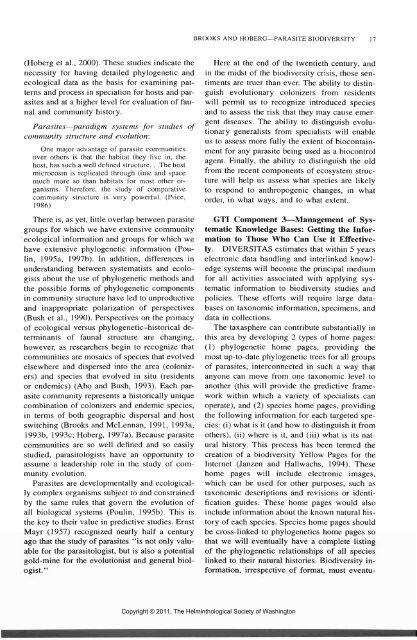Comparative Parasitology 67(1) 2000 - Peru State College
Comparative Parasitology 67(1) 2000 - Peru State College
Comparative Parasitology 67(1) 2000 - Peru State College
Create successful ePaper yourself
Turn your PDF publications into a flip-book with our unique Google optimized e-Paper software.
(Hoberg et al., <strong>2000</strong>). These studies indicate the<br />
necessity for having detailed phylogenetic and<br />
ecological data as the basis for examining patterns<br />
and process in speciation for hosts and parasites<br />
and at a higher level for evaluation of faunal<br />
and community history.<br />
Parasites—paradigm systems for studies of<br />
community structure and evolution:<br />
One major advantage of parasite communities<br />
over others is that the habitat they live in, the<br />
host, has such a well defined structure. . .The host<br />
microcosm is replicated through time and space<br />
much more so than habitats for most other organisms.<br />
Therefore, the study of comparative<br />
community structure is very powerful. (Price,<br />
1986)<br />
There is, as yet, little overlap between parasite<br />
groups for which we have extensive community<br />
ecological information and groups for which we<br />
have extensive phylogenetic information (Poulin,<br />
1995a, 1997b). In addition, differences in<br />
understanding between systematists and ecologists<br />
about the use of phylogenetic methods and<br />
the possible forms of phylogenetic components<br />
in community structure have led to unproductive<br />
and inappropriate polarization of perspectives<br />
(Bush et al., 1990). Perspectives on the primacy<br />
of ecological versus phylogenetic-historical determinants<br />
of faunal structure are changing,<br />
however, as researchers begin to recognize that<br />
communities are mosaics of species that evolved<br />
elsewhere and dispersed into the area (colonizers)<br />
and species that evolved in situ (residents<br />
or endemics) (Aho and Bush, 1993). Each parasite<br />
community represents a historically unique<br />
combination of colonizers and endemic species,<br />
in terms of both geographic dispersal and host<br />
switching (Brooks and McLennan, 1991, 1993a,<br />
1993b, 1993c; Hoberg, 1997a). Because parasite<br />
communities are so well defined and so easily<br />
studied, parasitologists have an opportunity to<br />
assume a leadership role in the study of community<br />
evolution.<br />
Parasites are developmentally and ecologically<br />
complex organisms subject to and constrained<br />
by the same rules that govern the evolution of<br />
all biological systems (Poulin, 1995b). This is<br />
the key to their value in predictive studies. Ernst<br />
Mayr (1957) recognized nearly half a century<br />
ago that the study of parasites "is not only valuable<br />
for the parasitologist, but is also a potential<br />
gold-mine for the evolutionist and general biologist."<br />
BROOKS AND HOBERG—PARASITE BIODIVERSITY 17<br />
Here at the end of the twentieth century, and<br />
in the midst of the biodiversity crisis, those sentiments<br />
are truer than ever. The ability to distinguish<br />
evolutionary colonizers from residents<br />
will permit us to recognize introduced species<br />
and to assess the risk that they may cause emergent<br />
diseases. The ability to distinguish evolutionary<br />
generalists from specialists will enable<br />
us to assess more fully the extent of biocontainment<br />
for any parasite being used as a biocontrol<br />
agent. Finally, the ability to distinguish the old<br />
from the recent components of ecosystem structure<br />
will help us assess what species are likely<br />
to respond to anthropogenic changes, in what<br />
order, in what ways, and to what extent.<br />
GTI Component 3—Management of Systematic<br />
Knowledge Bases: Getting the Information<br />
to Those Who Can Use it Effectively.<br />
DIVERSITAS estimates that within 5 years<br />
electronic data handling and interlinked knowledge<br />
systems will become the principal medium<br />
for all activities associated with applying systematic<br />
information to biodiversity studies and<br />
policies. These efforts will require large databases<br />
on taxonomic information, specimens, and<br />
data in collections.<br />
The taxasphere can contribute substantially in<br />
this area by developing 2 types of home pages:<br />
(1) phylogenetic home pages, providing the<br />
most up-to-date phylogenetic trees for all groups<br />
of parasites, interconnected in such a way that<br />
anyone can move from one taxonomic level to<br />
another (this will provide the predictive framework<br />
within which a variety of specialists can<br />
operate), and (2) species home pages, providing<br />
the following information for each targeted species:<br />
(i) what is it (and how to distinguish it from<br />
others), (ii) where is it, and (iii) what is its natural<br />
history. This process has been termed the<br />
creation of a biodiversity Yellow Pages for the<br />
Internet (Janzen and Hallwachs, 1994). These<br />
home pages will include electronic images,<br />
which can be used for other purposes, such as<br />
taxonomic descriptions and revisions or identification<br />
guides. These home pages would also<br />
include information about the known natural history<br />
of each species. Species home pages should<br />
be cross-linked to phylogenetics home pages so<br />
that we will eventually have a complete listing<br />
of the phylogenetic relationships of all species<br />
linked to their natural histories. Biodiversity information,<br />
irrespective of format, must eventu-<br />
Copyright © 2011, The Helminthological Society of Washington
















